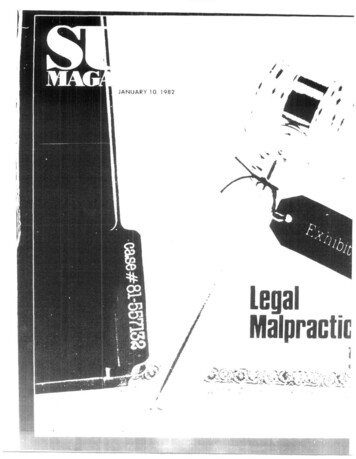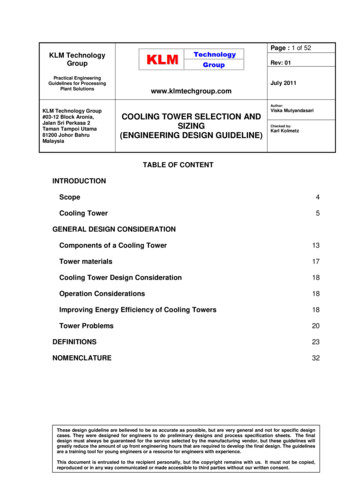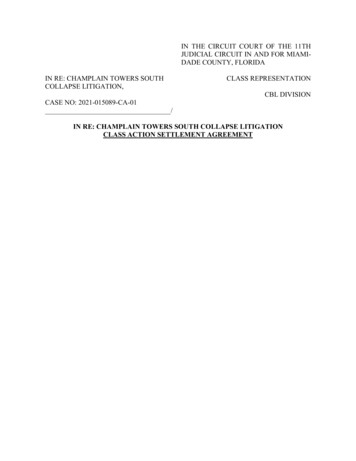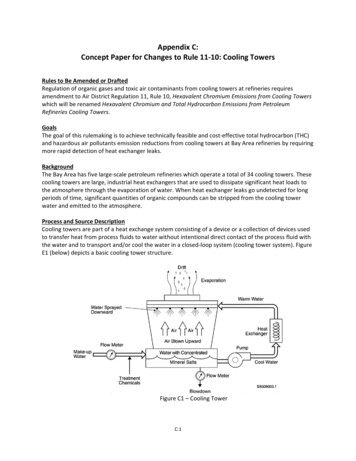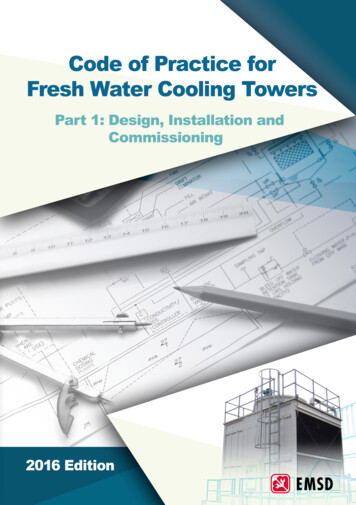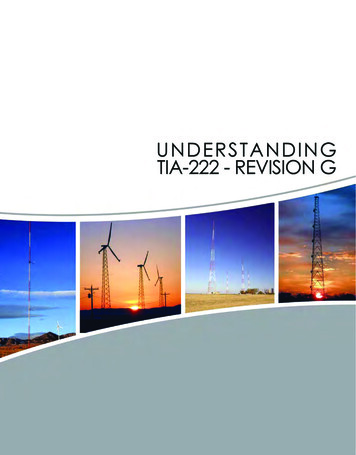
Transcription
INSTITUTE FOR SUSTAINABLE ENERGY, UNIVERSITY OF MALTASUSTAINABLE ENERGY 2014:THE ISE ANNUAL CONFERENCEThursday 20th March 2014, Dolmen Hotel, Qawra, MaltaISBN 978-99957-0-668-5THE AL BAHR TOWERS – ENHANCING SUSTAINABILITY THROUGH INNOVATION1K. Xuereb1Arup, 13 Fitzroy Street, London W1T 4BQ, United KingdomTel: ( 44) 02077555443, Fax: ( 44) 02077553743Corresponding Author E-mail: konrad.xuereb@arup.comABSTRACT: This paper presents the Al Bahr Towers recently completed in Abu Dhabi. It describes theinnovative adaptive facade that wraps around the towers and adapts in accordance to the solar incidence tocontrol solar heat gain and optimise daylight within the buildings. The paper reports the studies carriedout to mitigate the risks inherent in implementing a novel shading system in a large building project. Itelaborates on how the façade was implemented and its sustainability credentials in relation to energyperformance of the project. The paper describes how daylighting was controlled by the Mashrabiya screenand the typology of the curtain wall lying behind it. A critique is made on the possible implementation of asimilar system in a Mediterranean climate.Keywords: Al Bahr Towers, Mashrabiya, Sustainability, Innovation1 INTRODUCTIONThe award-winning project was conceived bythe Abu Dhabi Investment Council (ADIC) during aperiod of intense construction activity in the UAEthat also saw a regional drive towards implementingsustainable measures in building projects. Thecurrent stock of construction in Abu Dhabi,including Masdar city, reflects its intent to becomea world city in a post fossil-fuel age.Following an international design competition in2008 the design bid submitted by London-basedarchitect Aedas, together with Arup asmultidisciplinary engineering designer, was chosenas the winning entry by the client body. Arup wasinvolved from the competition through to theconstruction stage, providing the full range of designservices and specialist advice, from the coredisciplines of SMEP (structural, mechanical,electrical, public health) engineering to specialismslike environmental physics and advancedtechnology. Construction began in March 2009 andwas completed in early 2013.The Al Bahr towers, located in the financial centreof Abu Dhabi, comprise two quasi-identical, 26storey, 150m tall buildings. See Figure 1. Thetowers are the latest addition to Abu Dhabi’s everchanging skyline and their architecture embracesIslamic geometric patterning. They feature aninnovative dynamic shading screen, the Mashrabiya,which enhances the sustainable criteria of thedevelopment by optimising the use of naturaldaylight whilst controlling solar heat gain.2 PROJECT DESCRIPTIONThe site is located in the south-east part of theAbu Dhabi city peninsula, at the junction betweenAl Salam Street (8th Street) and Al Saada StreetWest (19th Street), in a zone allocated for businessdevelopments by the city’s authorities.The two towers are primarily designed for officeuse but also contain ancillary space that includesFigure 1: View of the towers from the North9
auditoria, prayer rooms, plant rooms and agymnasium. They share a two-storey basement thatfunctions predominantly as a car park and includesseveral large plant areas, a secure vault, and variousback-of-house areas.Between the towers, a 100 m wide curved roofforms a shallow dome over the entrance podium, itsfront partially glazed and forming a dramaticentrance to the buildings. Visitors enter this fullyconditioned space and can proceed directly to eithertower (Figure 2). The podium incorporates thegrand entrance lobby, a 200-seat auditorium, maleand female prayer rooms, back-of-house areas, tworestaurants with associated kitchens, and plant. Amezzanine floor is hung from the front edge of theoverlying foyer roof. This space forms the cafeteriaarea and is directly above the heavily glazed mainentrance. Solar panels at podium level are used topreheat the hot water supply for the buildings.temperatures and intense solar radiation thatcharacterise the local environment. The innovativeidea was to develop an external movable shadingsystem, the “Mashrabiya”, named after the form ofshading screen that had been used for centuries inIslamic architecture. See Figure 3.2.1 TOWERSThe towers are elliptical on plan and cylindricalin section. A centrally located, 20 m diameter, coreprovides lateral stability to each tower. The coreaccommodates passenger and goods lifts, togetherwith ancillary rooms, storage and plant equipment,thus freeing the floor plates for office use. Therepetitive core layout enhanced efficiency andfacilitated the construction process.Figure 2: Podium and mezzanine between towersBoth towers incorporate multiple-storeyskygardens over part of their perimeters. These actas buffer zones between the office space and theexternal environment along the height of the towers.The crown, a vaulted observation level, tops eachtower and offers spectacular views of thesurroundings.Figure 4: Construction of towers, showing recessesin floor plates to form the skygardensThe perimeter structure consists of steel columnsfollowing a honeycomb geometry to fit thearchitectural concept. See Figure 4. The trussednature of the perimeter structure contributesapproximately 10% of the superstructure’s overalllateral stiffness. The geometry of the perimeterstructure also adds resilience under accidentalloading by providing alternate load paths to adjacentperimeter columns.Primary steel beams span radially between theconcrete core and the perimeter steel columns, andedge steel beams connect into the perimetercolumns. The trapezoidal floor plates are formed byFigure 3: Traditional shading screens used invernacular Islamic architectureA key design driver was to develop a buildingenvelope that was both efficient and iconic, relatedto Islamic architecture and also embodying a novelapproach to reducing the effects of the high ambient10
thin composite floor decks. The steel beamscantilever beyond the edge beams to formconnecting positions for the supporting arms of theMashrabiya (Fig 5).As the primary business functions of the towersinclude financial transactions, brokering anddealing, resilience of the building services was a keyconsideration in the design. Each tower incorporatesa data centre at level 2 and a series of subequipment rooms at each level of officeaccommodation. In terms of cooling and powersupply, these facilities were designed to be highlyresilient and able to continue operating in the eventof primary system failure. This resilience isprovided primarily by N N system redundancy (ieeach component has an independent back-upcomponent) in terms of both cooling and electricalsupply. Cooling is maintained by two whollyindependent chilled water systems, while theelectrical supply has both dedicated UPS(uninterruptable power supply) systems in eachtower (in dedicated plant areas on level 1) and dieselgenerator back-up at ground floor level at the rear ofthe podium.Figure 5: Mashrabiya installed onto supportingsteelworkThe tower floor plates outside the coresaccommodate open-plan office space, cellularoffices and meeting rooms. These areas areprovided with ventilation and cooling from aconcealed fan coil unit system distributing temperedair to the occupied zone. Detailed co-ordination ofthe services integrated in the suspended ceiling(including grilles, lighting, sprinkler heads, smokedetectors and occupancy sensors) resulted in anelegant system that both allowed straightforwardinstallation and enables adaptability to future layoutchanges.Level 17 is designated as a plant floor andcontains ventilation plant equipment for iate chilled water pumps and associatedelectrical switching and life safety equipment.Additional ventilation plant levels 27 and 28 servethe crown and executive areas. Two central AHUs atlevel 17 provide tempered outside air to individualfan coil units at each level; the AHUs incorporateheat recovery devices to reduce the duty associatedwith cooling warm humid outside air to suitablesupply conditions. Heat is effectively recoveredfrom both general accommodation extract and WCextract.The peak cooling load for the entire building isapproximately 10.5 MW, which is met by a series offour water-cooled chillers at basement level. Eachincorporates two variable-speed compressors withthe aim of maximising performance and efficiency.The BMS (Building Management System) controlsthe sequencing of the chillers and their associatedprimary circulation pumps, depending on thevarying cooling load in the building. Heat rejectionis accommodated at podium roof level, where twobanks of cooling towers are carefully integrated intothe raking podium roof structure and concealed byan architectural aluminium mesh overcladding.2.2 SKYGARDENSA key architectural feature of the towers is theintroduction of skygardens on the southernelevations of both towers (Fig 5).Figure 5: Axonometric view of tower showingtypical office floor layout at skygarden levelThese are three- and four-storey open-air spacesthat are formed by the removal of a section of thefloor plates over a number of levels to createdramatic outward-facing environments.The skygardens are separated from one anotherby several floors. The perimeter steel frame wrapsaround the skygardens to support the modularMashrabiya devices. This creates a shaded externalenvironment that allows employees to step into anexternal environment along the height of the towers.See Figure 6.11
The design aspiration was to achieve a highlyglazed building, allowing spectaular views from theinside whilst providing the best possible levels ofinternal visual and thermal comfort. The designapproach sought was to adopt a more transparentglass than typically used for similar glazedbuildings in the region, as this would result in keybenefits including enhanced daylighting within thebuilding, reduced use of artificial lights andassociated energy saving.The key difficulty was keeping the sun out reducing the energy use associated with providinginternal comfort was perhaps the biggest singlechallenge faced by the design team. The solutionwas the innovative Mashrabiya shading deviceswhich wrap the Al Bahr towers. In fact, theMashrabiya became a key architectural theme in thetowers’ design.The design team undertook extensive solar andthermal analysis of the effect of this unique activeshading system on select areas of the towers atvarious times through the year to identify therequired extent of the shading device and its regimeof opening and closing (Fig 8). This helped derivethe precise portion of the North facing facade whereshading is not required.Figure 6: Completed skygarden from within officespace.3 TOWER FACADES – THE MASHRABIYAThe climate in Abu Dhabi is classified assubtropical desert, having maximum temperatures ofaround 46 C and very high solar radiation levelsyear-round (Fig 7).Figure 7: Average diurnal temperature range inAbu DhabiFigure 8: Solar exposure analysisMost recent high-rise buildings in the MiddleEast use highly glazed façades with dark, reflective,or body-tinted glass. This type of solution limitssolar gain, but significantly reduces naturaldaylighting and general internal comfort. Frequentuse of internal blinds is normally needed to controlglare effects and this inevitably increases thelighting energy consumption, defeating the purposeof a transparent building.As built, the Mashrabiya clads the towers ontheir east, south and west façades, significantlyreducing solar gain to the internal accommodationand permitting the use of floor-to-ceiling clearglazing. Different options were investigated toselect the most appropriate fabric for the shadingsystem, and PTFE-coated glassfibre mesh wasidentified as the most durable and best- performingsolution.12
In total, each tower has 1049 Mashrabiya panels,with each weighing about 600 kg (1.5 tonnes withsupporting steel brackets). Arup built on knowledgegained in other projects with movable elements, andworked with the architect to conceive schematicparameters for these elements and their detailedperformance specifications.Various conceptual arrangements were assessedearly in the design, including connecting all shadingelements to one another and into the superstructure,but this led to conflicting behaviours between theMashrabiya and the internal support structure. Amore straightforward strategy was thus sought, inwhich each Mashrabiya was conceived as a unitisedsystem cantilevering 2.8 m from the primarystructure. The supporting arms allow connection tothe ends of six adjoining Mashrabiyas, and eachshading device has different releases at each of threesupporting nodes.The shape of the building in plan and elevationled to 22 different variations in the Mashrabiyageometries, which in itself created a technicalchallenge for managing their manufacture andassembly. No precedents of moveable shadingsystems on this scale were available and most of thedesign team’s efforts focused on making sure that thisunique and unconventional shading system was ableto protect the buildings from solar radiation whilstoperating reliably in an aggressive environment.A series of prototype tests on a fully functional1-to-1 scale shading panel were therefore carried out,including wind tunnel tests and accelerated tests in aclimatic chamber. More than 30,000 openingclosing cycles were simulated at differenttemperature conditions (carying from 24 C to 30 C) and at different levels of relative humidity, whilstapplying sand and salt water on all the critical joints.This step was essential to de-risk the design processand prove the required durability life of actuators,bearings and mechanisms. A full-scale mock up wassubsequently erected on one of the towers, while thecurtain wall was being installed, to allow theMashrabiya mechanism to be tested in situ (Figs 911).The result is a responsive and dynamic skin,able to react differently according to the sun’sorientation and to adapt to varying externalconditions throughout the year. As a result, thebuilding’s appearance is always changing, reflectingnatural daily and seasonal rhythms. By detailedassessment of the combined shading and glassperformances, a correct balance between solarcontrol and light penetration has been achieved. Thetype of glass selected has a clear appearance withhigh visible light transmittance, enhancing thedaylighting and the view through, while the externalshading panels help reduce the solar radiationsignificantly — and only where and when needed.As a result, the Mashrabiya are designed to reducethe towers’ carbon emissions by 20 percent.Figure 9: Mock-up Mashrabiya in situFigure 10: Mock-up Mashrabiya in situFigure 11: Mock-up Mashrabiya in situThe Mashrabiya elements are grouped in sectorsand operate by sun tracking software that controlsthe opening and closing sequence according to thesun’s position. If necessary, the system can beoverridden to control individual panels from a deskin the BMS control room. The control system islinked to an anemometer at the top of the buildingwhich will automatically prevent operation of theshading, and will retract the units if the wind speedexceeds the peak operating threshold. A similarapproach, using solar radiation sensors, is used totrigger the opening of the Mashrabiya panels inprolonged overcast conditions.13
The principle for access and maintenance of theMashrabiya and curtain wall is via a BMU (BuildingMaintenance Unit) basket running externally withinthe cavity between the two skins. The baskets aresupported by cranes on top of the central cores.transmission of 44%. Both values are significantlyhigher than any other similar building in the MiddleEast.Figure 13: Mashrabiya in open configuration –view from inside office4 THE CROWNThe crown was the subject of a separate solarand thermal analysis, so as to optimise theMashrabiya extension at this level, and verify wherethe external shading system would be required, toprovide an efficient cooling strategy. A 3-D modelof the tower was carried out for the solar analyses.A simplified section of the top part of the tower wasderived for a first solar exposure review, while amore detailed model was used for the sun pathanalysis.Figure 12: View of lower levels of south east towerThe curtain wall behind the shading is a standardunitised system shaped around the Mashrabiyabrackets and developed to accommodate variablebuilding geometries. The design and overall shapeof the building were optimised to improve the panelrepetitions, limiting rectangularity deviation and anywarping. This helped to significantly reduce thesystem’s complexity and ultimately the costs.The vision area within the tower floor platesconsists of floor to ceiling high double glazed units,with laminated inner and monolithic outer panes,both heat-strengthened. The heavily shaded natureof the towers having reduced gains due to solarradiation, entails that conductive gains fromtemperature difference is a determining factor.Particular attention was therefore paid to enhancethe thermal performance by specifying Argon filleddouble glazed units and introducing thermal breakswhere the brackets supporting the Mashrabiyapenetrate the thermal line.The building physics analyses carried out werecrucial to define the correct balance between solarcontrol and light transmission performances of theglazing and shading components, and the effect ofthe combined systems. A clear glass with a highperformance coating has been selected, achieving ag-value (solar control) of 0.26 and a lightFigure 14: Total summer radiation in summerconditions at 9amThe solar exposure study (Figs 14,15) suggestedthat at the top of the tower, the Mashrabiya systemshould follow the configuration already conceivedfor its lower portions. However, due to thearchitectural desire not to extend the Mashrabiya tothe very top of the crown and due to the shadingsystem’s distance from the façade, additional designmeasures were required to ensure that solar gainsthrough the façade within the height of the crownwere reduced below the target limit.14
site, the contractor took over this responsibility.The final predicted rating is LEED Silver.6 CRITIQUE ON THE APPLICABILITY OF THESYSTEM TO THE MEDITERRANEAN REGIONThe climate of the Mediterranean region is atype of subtropical climate, with high solarradiation levels. The maximum temperaturesexperienced are lower than those in the UAE.The adaptable envelope conceived for the AlBahr Towers could be applicable in principle tosimilar building projects in the Mediterraneanregion. A key parameter for the successfulimplementation of the Mashrabiya system on the AlBahr Towers was the awareness by all the partiesinvolved, including the client body and investors, ofthe inherent risks in implementing such a largescale novel entity in the buildings and the collectiveendeavour to mitigate the risks at all stages of theproject to transform the idea into a reality.The additional tests required to mitigate the riskin adopting the system invariably had an upfrontcost premium. Thus, there needs to be anunderstanding and financial commitment by fundingentities to commit to these necessary procedures.The additional upfront costs (mostly incurred byadditional tests) need to be weighed against theenergy savings of the building in opereation –especially in Europe where energy costs areconsiderably higher than the Middle East.Photovoltaic panels were deemed unfeasible onthe Al Bahr Towers, resulting in pay back periodsin excess of the life expenctancy of the panelsthemselves. However, this may not be the case inthe southern Mediterranean region, where theenergy performance of an analogous buiding wouldbe enhanced by the introduction of photovoltaicpanels.Figure 15: Shadow mask used to proveeffectiveness of Mashrabiyas at the top of the crownto assess whether additional measures are requiredThe glass performance in this area was improvedby applying additional fritting with a variablepattern according to the level of solar controlrequired. This reduced the g-value and contains thesolar gains (Fig 16).Figure 16: Modified shading systemUse of photovoltaic panels was considered onthe roof surfaces of either tower. However, thepresence of the two BMU cranes on either rooflimited the area available. Furthermore, given waterscarcity in the UAE, considerable energy isconsumed for the desalination process to producewater to clean the PV when compared to the energyactually produced by the panels. Anotherdetermining factor was the potential deposition ofairborne dust on outdoor photovoltaic modules.This could decrease the transmittance of solar cellglazing and cause a significant degradation of solarconversion efficiency of PV modules. The abovereasons and the relatively low electricity prices inthe UAE made the use of photovoltaic panelsunfeasible.7 CONCLUDING REMARKSThe Al Bahr towers are now a notable landmarkin Abu Dhabi’s financial district. Their adaptableskins, the Mashrabiya, form a key feature of theproject, responding to the external environment,considerably reducing heat gain, and enhancingsustainability credentials.The project won the 2012 Council for TallBuildings & Urban Habitat’s (CTBUH) InnovationAward, and was listed amongst the “Innovative 20”tall buildings that “challenge the typology of tallbuildings in the 21st Century”. It also featured in theNovember 2012 Time as one of the “25 bestinventions of the year”. It recently also won the2013 Society of Facade Engineering Awards and5 PROJECT SUSTAINABLE CREDENTIALSThe project is being assessed under the USGreen Building Council’s Leadership in Energy andEnvironmental Design (LEED) tool. LEEDconsiders areas such as energy efficiency, land use,water consumption, occupant comfort and materialsspecification. Comprehensive and flexible, LEED isa green building tool that addresses the entirebuilding lifecycle, recognizing best-in-classbuilding strategies. The Architect acted as theLEED administrator for the project during design,collating evidence from the rest of the team from anearly stage to determine the target rating. Once on15
the 2013 Middle East Architect Awards for bestoverall building and best commercial building.5. -of-the-year-2012/6. architect-awards-20137. irst-facades-award8. K. Xuereb et al, In the Shade: Al Bahr Towers,The Arup Bulletin (June 2013)Image credits1, 5, 17 Aedas;3, 6, 7, 8, 9, 10, 11, 12, 13, 14, 15, 16 Arup;2, 4 DIARProject creditsClient: Abu Dhabi Investment Council, UAEArchitect: Aedas, LondonMultidisciplinary engineering designer: Arup,multiple offices (Façade, Structure, BuildingServices, Civil Engineering, Geotechnics, Lighting,Acoustics, Fire, Wind, Security, Traffic, VerticalTransportation, IT and Comm, CateringConsulting).Façade A&M: Reef, London.Architect and Engineer of record: Diar Consult,Abu Dhabi, United Arab Emirates.Cost consultant: Abu Dhabi office of AECOM(formerly Davis Langdon).Project manager: Mace, LondonMain Contractor: Al-Futtaim Carillion LLC, AbuDhabi, United Arab Emirates.Façade Contractor: Yuanda China HoldingsLimited, Shenyang, China.Figure 17: View of completed towersREFERENCES1. P. Oborn, Al Bahr Towers, The Abu DhabiInvestment Council Headquarters, Wiley, ISBN978-1-119-97415-4, (2013).2. http://www.leeduser.com/rating-systems/NCv2.2/ leed-new-construction-v2.23. ww.ctbuh.org/LinkClick.aspx?fileticket JVPxRjG1wyY%3D&tabid 3359&language en-GB16
INSTITUTE FOR SUSTAINABLE ENERGY, UNIVERSITY OF MALTA SUSTAINABLE ENERGY 2014: THE ISE ANNUAL CONFERENCE Thursday 20th March 2014, Dolmen Hotel, Qawra, Malta ISBN 978-99957--668-5 9 THE AL BAHR TOWERS - ENHANCING SUSTAINABILITY THROUGH INNOVATION K. Xuereb1 1 Arup, 13 Fitzroy Street, London W1T 4BQ, United Kingdom Tel: ( 44) 02077555443, Fax: ( 44) 02077553743


